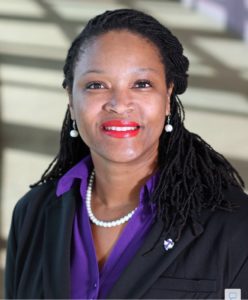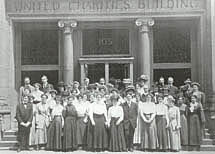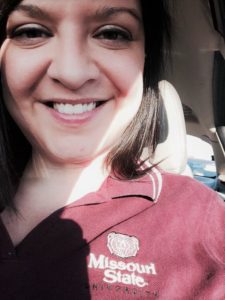Teaching with Infographics: My experiences with digital literacy and non-traditional students
Nathalie P. Jones, PhD, MSW is an Assistant Professor of Social Work at Tarleton State University. In this blog post, Dr. Jones writes about her experiences creating and implementing an infographic assignment with nontraditional social work students.
As an Assistant Professor of Social Work at Tarleton State University, I have absolutely enjoyed educating social work students on the use of technology through macro social work practice courses. I teach a large number of non-traditional learners (those who have been out of school for longer than one year, and are employed, parenting, or in any other roles that are competing with being a learner as defined by the National Center for Education Statistics [2015]). I find that they develop student groups quickly in order to have support while working on assignments, especially those assignments that include the use of digital technology.
To help my students improve their understanding of digital and social technology, I have introduced the use of infographics during an advanced social work course entitled Women’s Issues. Infographics are visual representations of almost any type of information. Infographics are similar to storytelling with visual content and supported with statistical data. They are an effective way to communicate large amounts of information in a clear and succinct way, and are an increasingly popular tool in popular media and the non-profit world (NonProfit Tech for Good, 2014). Understanding how to create, share and evaluate infographics is a key digital literacy skill for social workers (Shelly, 2015). Along with all these benefits, I wanted to create an assignment that was fun and engaging for my nontraditional students who are often nervous about nontraditional, digital assignments.
For the Women’s Issues course, I asked students to research an issue or social problem affecting women, turn that research into an infographic (rather than a written paper), and then share their infographics with professionals outside of the class as a way to network with alliances who advocate on behalf of women. This meant students needed to not only create a quality artifact for a grade, but also learn how to share it with other advocates in a public way – via social media. In an effort to support learners who were experiencing technology in college for the first time, I provided them with seven detailed steps to successfully complete the infographic assignment. These steps involved learning about Twitter as well as creating an infographic.
Here are the assignment steps directly from the course syllabus:
Step 1: Create a Twitter Account & provide your Twitter Handle. *Don’t forget to follow the instructor.
Step 2: Research & provide a resource of two infographics (1) from the web and (1) from Twitter related to Women’s Issues. Then, provide a 1-2 page comparison on how the infographic was distributed, what was learned & why this is a resource for issues related to women.
Modeling Practice: Social Media Guidelines in Social Work Field Education
Last year, I wrote my own profession guidelines for how I use social media in my professional practice as a social work educator. This is often referred to as a Professional Social Media Policy, and is a recommended practice from National Association of Social Workers (NASW, n.d.). Specifically, these guidelines are personal to me, and describe how I strive to interact with students, colleagues and other professionals when using digital and social media. I include these guidelines in my course syllabi and they guide how I use social media to engage students online, disseminate my research, and network with colleagues.
These guidelines came about because of a collaborative project with Allison Curington, Director of Field Education at the University of Alabama. We have been working a toolkit to help social work field educators deal with ethical and practical issues related to the use of social and digital media in field education, focusing on information and tools to help field directors raise awareness with students and field supervisors. As part of this process, Allison also wrote her own professional social media policy. She then decided to ask the entire staff in the UA Office of Field Education to assess their social media use for their own policies. In this interview style post, Allison shares her thoughts about how the process worked and the UA Field Staff developed their own professional social media policies.
How did you write your own policy? How did you approach this process?
Navigating the landscape of technology and social media has been quite the challenge in field education. I can remember when MySpace was all the rage as I was beginning my career as a field director. However, there were very few students in our graduate program who participated on social media platforms. Honestly, we were just trying to navigate not having enough cell phone coverage in rural areas at that time! Fast forward 13 years and you have an entirely new landscape. I would have never dreamed as a field director that I would be dealing with a generation of students who use their primary mode of communication with something other than the phone, e-mail, or even snail mail.
Know your Social Work History: Pioneering Health Care for Children with Disabilities
A little unknown fact about me – one of my first scholarly interests as a future academic was and still is social welfare history; exploring the roots of the social work profession in the United States. As a doctoral student at the University of Alabama’s (UA) School of Social Work, I was fortunate enough to work with Dr. Paul Stuart, a leading social welfare historian and, now, Professor of Social Work at Florida International University. I took several classes with him about social welfare policy and historical research methodology. Along with being my academic advisor and chair of my dissertation committee, he helped me to develop an interest in how the history of social work profession has a direct and meaningful influence on today’s social workers and social welfare agencies. Through reading and research from my course work, I quickly learned that there was a gap in the social welfare history literature on the intersection of social work and public health in early 20th century in the United States. Using my background in public health and social work, I developed a research topic which turned into my dissertation and the foundation of my interest in social welfare history – the history of health and social services for children with disabilities.
I write all this because I just had a second article published from my dissertation research:
Hitchcock, L. I., & Stuart, P. (2017). Pioneering Health Care for Children with Disabilities: Untold Legacy of the 1916 Polio Epidemic in the United States. Journal of Community Practice. Retrieved from http://www.tandfonline.com/eprint/BDSf39bKsz2ffnn6zMFb/full
The Shared Case Study: An online activity for Interprofessional Teamwork
Natalie Curry, LCSW is a Clinical Instructor at Missouri State University’s (MSU) School of Social Work. She has been on the faculty with MSU for two years and prior to that was an adjunct instructor for MSU, Drury University, and Washington University in St. Louis. Prior to entering academia, her practice background includes working with individuals who were homeless in various capacities, inpatient psychiatric care, and behavioral health consulting in primary care. In this post, she writes about an online, interprofessional learning activity that she helped to develop and implement with colleagues at MSU You can follow Natalie on Twitter at @natalielcsw.
Last fall, there was considerable interest around interprofessional education in the College of Health and Human Services (CHHS) at Missouri State University (MSU), where I work. My colleagues and I believed that we were doing well at talking with our students about how much collaboration they would do in their careers with other healthcare professionals. But we wanted to go further and figure out ways to provide the students real opportunities for interprofessional practice in their educational programs. That was part of the motivation for bringing together faculty from all 11 disciplines (such as social work, nursing, medicine and others) within CHHS, in addition to the University of Missouri-Kansas City School of Pharmacy which was already in partnership with MSU. The other part of motivation was a growing recognition that interprofessional activities were no longer just encouraged in many of our disciplines’ accreditation standards; they were required.
Starting in Fall 2015, our committee to begin developing interprofessional educational activities for our students. We met monthly and eventually decided that it was not feasible to develop one activity, project, or experience that all students from CHHS could do together and still be meaningful. We decided on four “menu items” that each discipline could choose to participate in, depending on the needs of their students. We wanted to have a mix of interprofessional activities, ranging from one-day experiences to projects that could be implemented over the course of a semester.






